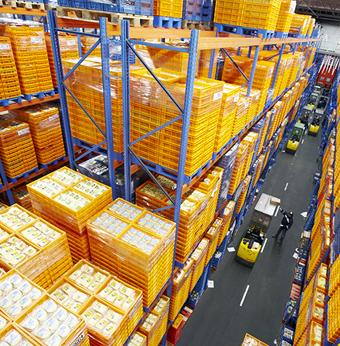 Colruyt Group will add fuel cells at its distribution centre . |
By Luc De SmetBelgian retailer Colruyt Group will this week receive the first 75 of 200 drop-in PEM fuel cells which it will install in its class 3 pallet jacks of 1,000 to 2,000 kg for low-order picking and double-length forks at its Dassenveld distribution centre at Halle near Brussels. The Plug Power 24 V GenDrive fuel cells, specifically designed for pallet jack electric trucks, can hold 0.5 to 0.8 kg of hydrogen at 350 bar.
Colruyt Group is using the fuel cells mainly on new equipment, but also on existing equipment that has already been converted.
In 2012, it tested a class 1 Crown forklift, nine class 3 stand-and-ride order pickers and jacks and one class 2 reach truck. In 2013, the retailer also tested a thermal Still RX70-25 that was converted for hydrogen burning by Blue Planet Hydrogen, but it discontinued that particular technology.
The hydrogen equipment will be operational in areas that run 24 hours a day in three shifts.
"In the past, we have not really tested this technology thoroughly in the chilled area. That is one of the topics that we'll be doing now," says Tom Valcke, project engineer - energy and environment at Colruyt Group. Another difference from the past is that the new machines will be 'operational' and not 'in test'. "So we will be closely monitoring productivity gains," says Valcke.
The first batch of 75 trucks comes with research funding from the Flemish-Dutch Interreg Waterstofregio 2.0 program.
"In that program, we also will demonstrate an innovative indoor dispenser," he says. Until now, the retailer has used an external multifunctional H2-dispenser that filled all its H2 mobile applications - cars and trucks - on the site. In the future, two new indoor dispensers will be installed in the warehouse where operators will fully charge their machines in about 90 seconds.
The introduction of the new technology will not dramatically impact on current conditions. "We will have a lot less batteries and chargers to worry about, though," says Valcke. In the vicinity of the current charging room, which is naturally fully equipped to ventilate possible H2 discharges, a space has been created for maintaining the H2 machines. "Our maintenance unit has a first-line function. The supplier of the cell will service the cell. The supplier of the machines is called upon for corrective maintenance."
The switch fits Colruyt Group's 'zero emissions' strategy. That does not mean it will not consider other technologies, such as lithium-ion. "We are, however, surprised lithium-ion is still difficult to get. There is little experience with the technology and the price is not what we expect it to be. According to our calculations today, hydrogen is an alternative." Furthermore, hydrogen, which fits in with its strategy of making fuels more sustainable, allows Colruyt Group to store and buffer energy. The company is part of the EU Don Quichote research project in which it uses the H2 it generates as an energy buffer to produce some 90-120 kW of electricity.
"In pure logistical terms, the H2 trucks should provide us with more time efficiency," Valcke concludes. "Going for H2 also allows our DC to store excess renewable energy."